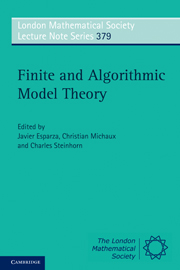Book contents
- Frontmatter
- Contents
- Preface
- 1 Automata-based presentations of infinite structures
- 2 Logical aspects of spatial databases
- 3 Some connections between finite and infinite model theory
- 4 Definability in classes of finite structures
- 5 Algorithmic meta-theorems
- 6 Model theoretic methods for fragments of FO and special classes of (finite) structures
- Bibliography
3 - Some connections between finite and infinite model theory
Published online by Cambridge University Press: 01 June 2011
- Frontmatter
- Contents
- Preface
- 1 Automata-based presentations of infinite structures
- 2 Logical aspects of spatial databases
- 3 Some connections between finite and infinite model theory
- 4 Definability in classes of finite structures
- 5 Algorithmic meta-theorems
- 6 Model theoretic methods for fragments of FO and special classes of (finite) structures
- Bibliography
Summary
Introduction
Most of the work in model theory has, so far, considered infinite structures and the methods and results that have been worked out in this context cannot usually be transferred to the study of finite structures in an obvious way. In addition, some basic results from infinite model theory fail within the context of finite models. The theory about finite structures has largely developed in connection with theoretical computer science, in particular complexity theory [12]. The question arises whether these two “worlds”, the study of infinite structures and the study of finite structures, can be woven together in some way and enrich each other. In particular, one may ask if it is possible to adapt notions and methods which have played an important role in infinite model theory to the context of finite structures, and in this way get a better understanding of fairly large and sufficiently well-behaved classes of finite structures.
If we are to study structures in relation to some formal language, then the question arises which one to choose. Most of infinite model theory considers first-order logic. Within finite model theory various restrictions and extensions of first-order logic have been considered, since first-order logic may be considered as being both too strong and too weak (in different senses) for the study of finite structures.
Information
- Type
- Chapter
- Information
- Finite and Algorithmic Model Theory , pp. 109 - 139Publisher: Cambridge University PressPrint publication year: 2011
